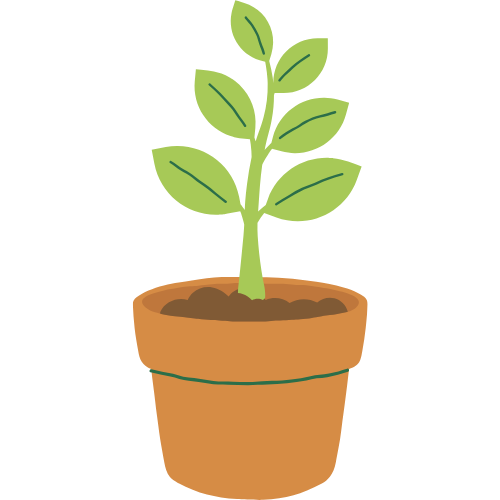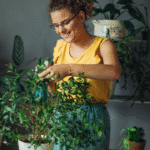Selecting the correct soil can be called one of the most critical choices of a botany enthusiast who will drastically affect the health, vitality, and the life span of both indoor and outdoor plant life. Distant to being used as a mirror to support roots, soil is a mini ecological region that furnishes support, food, water, and air all of which the plants need to grow. It is very important to know the different needs of the different plants and what soil would suit each type of plant in cultivation of a lovely garden, be it an enormous outdoor garden bed or a small indoor set.
The Secrets of Soil: Getting to Know the Basics of Soil
Before getting into the details of the particular plant requirements, it is important to understand the essence of the main constituents and features of the healthy soil. Soil, in general, is a composite of mineral (sand, silt and clay) particles, organic matter, water, and air. The relative amount of these components determine the aquifer properties, such as the texture of the soil, water infiltration, water retention, and nutrient retention of the soil.
Texture
This is the dimensions of the mineral grains.
- Sand: The biggest ones, with the best drainage and aeration, and the worst water and nutrient retention.
- Silt: Particles of medium size that provide an optimum balance between drainage and water retention.
- Clay: These are the smallest, with high amounts of water and nutrients, and usually not so good at draining and aeration when compacted.
Organic Matter
It is broken down plant and animal substance. It is the vitality of good soil, enhancing soil structure, water holding capacity, nutrient intake and food source to good microorganisms.
Drainage and Aeration
Capability of water movement through the soil and air moving around the roots. The result due to poor drainage is that the soil is waterlogged and roots are smothered and encourage rot.
Water Retention
It is the ability of the soil to absorb water, which will be taken up by plants.
Nutrient Content
Comprising of major (Nitrogen, Phosphorus, Potassium) and minor nutrients essential in the growth of the plants.
pH Level
It indicates the level of acidity or level of alkalinity in the soil, which determines the availability of nutrients. The majority of the plants grow well with a slightly acidic to neutral pH of between 5.5 to 7.5 and some have learnt to live in more extreme conditions.
Indoors soil preparation of the soil
Plants that grow indoors are subjected to an exceptional situation of soil demands, being trapped in pots. They live in an environment that is confined and controlled. Unlike the soil in nature, which is continuously renewed by nature, the soil used as growing medium in indoor potted plants deteriorates and requires special formulations to flourish.
Main features of good indoor Potting Mix:
- Light and Fluffy: To ensure that it gets good aeration and compaction is minimized; roots should be able to spread out with ease.
- Good Drainage: this is very important in avoiding waterlog, which is a very deadly condition of the indoor plants. Water that has leaked should have an easy way out.
- Maintaining sufficient Moisture: Though proper drainage is essential, the mixture should still be able to retain enough moisture before the next watering.
- Sterile: Commercially available potting mixes are often sterile to avoid introducing pests, diseases and seed of weeds into the indoor space.
- Balanced in Nutrients (Initially): Most mixes in the commercial market place contain a starting dose of nutrients, but these levels will have to be renewed subsequently through fertilization.
Typical Ingredients of Indoors Potting-Mixes:
- Peat Moss: This is very good at holding water and offering slightly acidic environment. Nonetheless, through environmental concerns, a number of people choose to use sustainable instead.
- Coconut Coir (Coco Coir): This potting medium is an eco-friendly alternative, preferred by many, having the same level of moisture retention and aeration that peat moss does. It is made out of coconut husks.
- Perlite: It is a lightweight, white volcanic rock that improves the drainage and the aeration, making air pockets.
- Vermiculite: An expanded mineral that has been hydrated and which contains water and gives it, enhancing water retention and aeration properties, and even neutrient retention.
- Bark or other Organic Matter, which is Composted: Provides structure, nutrients, and water retention.
- Sand (Coarse): You can use it in small quantities to promote drainage especially in succulents and cacti.
Indoors: selecting the appropriate indoor mixture of particular plants:
- General Houseplants (e.g., Pothos, Philodendron, Spider Plants): The most common and well-rounded all-purpose potting mix is one consisting of peat/coco coir, perlite and a dash of compost.
- Succulents and Cacti: The expressively rapid draining soil is imperative in this type of plant to make sure root rot does not develop. Search in mixes made with good quality succulents in mind, and they may include a greater percentage of perlite, pumice, or coarse sand.
- Orchids: Need a very porous, free draining medium that approximates to their epiphytic habit. Successful mixtures of orchids usually include fir bark, charcoal and perlite, with minimal or no conventional soil content.
- African Violets: They do best in the slightly aciditic moisture-retentive mix, but well-aerated. Special mixes of African violets can be obtained, usually including peat, vermiculite, and perlite.
- Germination: The sterile mix must have good moisture retention and drainage and should be a fine texture. Such ones will usually be formulated with a lot of peat or coir and small perlite or vermiculite.
Choice of Soil to Use Out-of-doors
Outside planting is more variable, and you have to go further with the soil you already have seen in the garden. In this case, the objective normally is to enhance the qualities of the native soil so that they are suitable to your plants.
Getting to know Thy Native Soil:
It is necessary to learn more about your current soil before you can make any amendments. An approximate idea may be given by a squeeze test:
- Sandy Soil: Crumbles under wet, grity. Drains quickly.
- Clay Soil: Wet, it clumps together into a sticky ball, smooth feeling. Sluggish to drain and may be compacted.
- Silty Soil: Smooth and a little is slippery when wet, can form a ball but easy to break apart. Good retention of water.
- Loam: The perfect soil which is a combination of sand, silt and clay. It crumbles readily, is a little dusty and smooth and retains moisture.
To get a better idea, it is necessary to engage in soil testing. To understand what is going on with your soil, professional soil tests will show the pH, nutrient levels and composition of your soil and will include suggestions of what to use to fix it.
Amending Soil in the Garden:
- Addition of Organic Matter: This is practically nearly all good. Compost, well rotted manure, leaf mould, or aged wood chips all enrich the structure of the soil, increase drainage in clay soils, water retention in sandy soils and nutrient availability.
- In the case of Clay soil: organic matter will loosen up heavy clay soil and make it more aerated (with improved drainage).
- In Sandy Soil: Organic matter aids in binding the sand particles hence retention of water and nutrient.
Adjusting pH:
- To raise PH (Make more alkaline): Add agricultural lime.
- To Alkalinize (Make more basic): Add soluble or elemental sulfur, peat moss or iron sulfate. Adjusting the pH of soil should always be done after a test. This is because improper adjustments may hurt the plants.
Addressing Drainage:
- Poor Drainage (Heavy Clay): Add a lot of organic matter and think about using raised beds to improve matters.
- In the case of Excessive Drainage (Sandy Soil): Do add organic matter in order to enhance water retention.
Selecting a Soil for Garden Potted Plants:
Containerized plants are more like indoor plants even when planted in the outdoor. Members demand special potting mix and not gardening soil. The garden soil on pots will compact, suffer ineffective drainage as well as bring in diseases and pests. Apply a high-quality general-purpose potting mix, as one would do with an indoor plant, but one that will best suit the requirements of the particular outdoor plant, in terms of both drainage and moisture.
Outdoor Plant Specifics:
- Annual Flowers and Vegetables: They are mainly soil lovers with high organic content that is well drained and loamy.
- Acid Love Plants (e.g., Azaleas, Rhododendrons, Blueberries): Need a soil with low pH but may also need a soil with low pH 4.5-5.5). Correct using peat moss, pine bark, or certain acid-lovers mixture.
- Drought-Tolerant Plants (e.g., Mediterranean herbs, some perennials): Will grow in well drained (even sandy soils). Avoid excessively rich, or non-water-shedding mixtures.
- Water-Loving Plants (e.g., some ferns, bog plants): May need soils of a more moisture retentive nature, sometimes with even an increased clay content or bespoke bog mixtures that recreate their natural environment.
The Never-ending Cycle of Soil Health
The selection of the right soil is not a destination. Containers soil deteriorates with time as nutrients in it wear out and organic substance decomposes. Outdoor beds also require the addition of organic material (compost, manure), and periodical repotting of indoor houseplants with a new batch of potting mix is key to overall long-term plant health.
With a little knowledge about the main concepts of soil science and how to make it work within the parameters of your succulent, or your growing condition, you can set the scene of a beautiful and lush garden, whether that looks like one potted succulent on a windowsill, or a whole flower bed in your garden.



